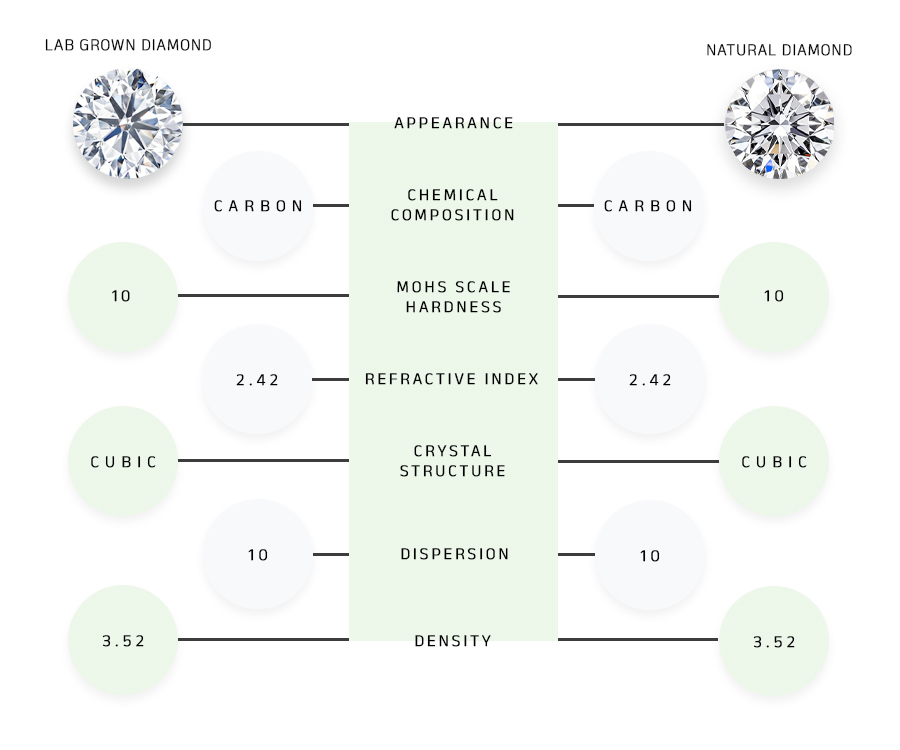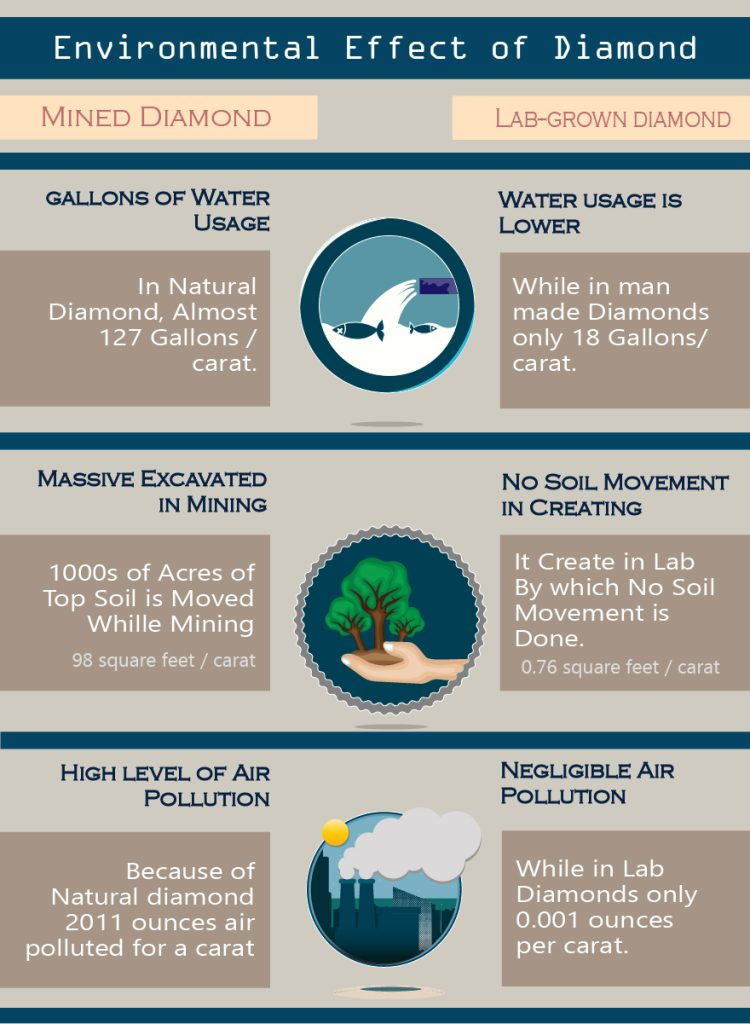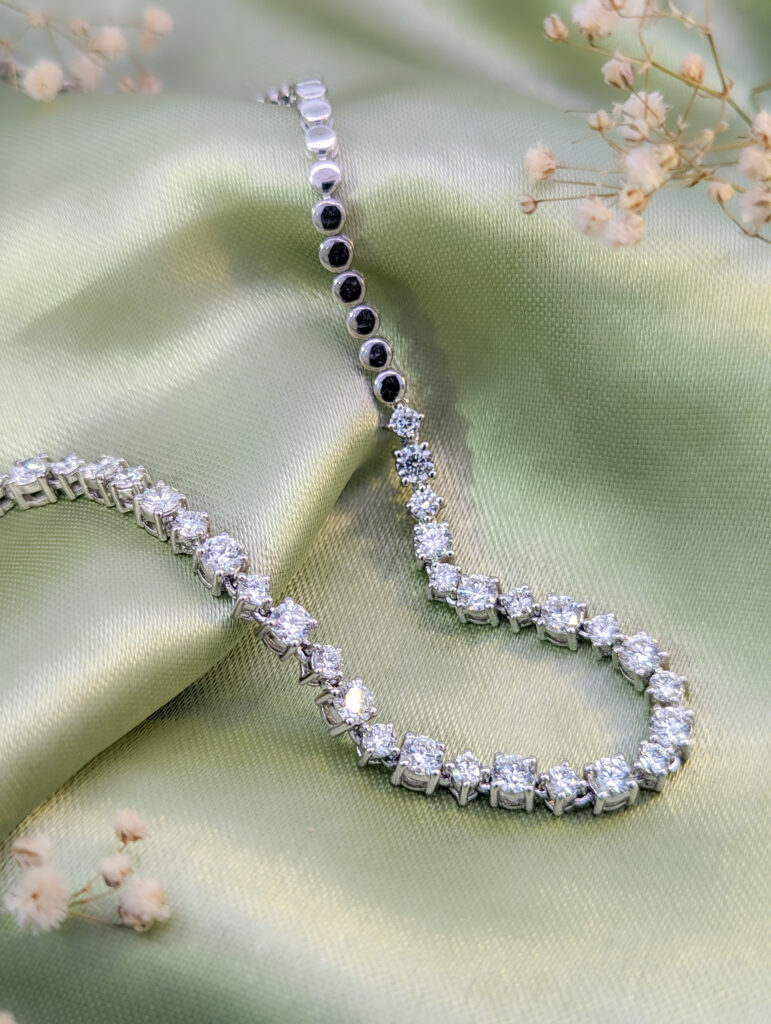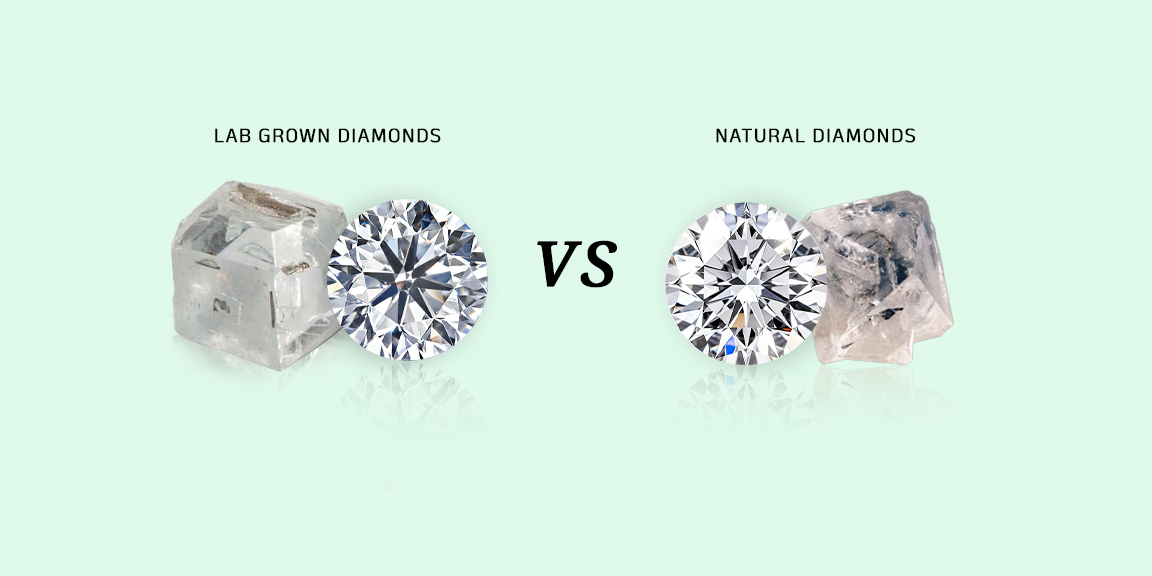Lab Grown Diamonds vs Natural Diamonds: A Complete Guide
The world of gemstones has long been associated with luxury, romance, and timeless beauty. However, as technology advances and consumer preferences shift, the diamond industry is witnessing a significant transformation. At the heart of this change is the growing popularity of lab grown diamonds, which offer a compelling alternative to their natural counterparts.
This guide explores the nuances of lab grown diamonds vs natural diamonds, providing insights into their formation, cost, and impact on the environment, exploring aspects such as sustainability, cost, ethical considerations, and market value. Whether you’re considering purchasing a diamond for an engagement ring or simply curious about these sparkling gems, understanding the nuances between lab-grown and real diamonds will empower you to make an informed decision that aligns with your values and desires.
What Are Lab Grown Diamonds?
Lab grown diamonds, which are also known as lab-created, are made in a lab. They are not fake or low-quality diamonds. Instead, they have the same chemical, physical, and optical properties as natural ones.
The way these stones are produced mimics the natural crystal growth that happens deep within the Earth. Using advanced techniques like Chemical Vapor Deposition (CVD) and High Pressure High Temperature (HPHT), a tiny seed serves as the foundation for growth, gradually building up layer by layer. Once grown, the rough pieces are cut, polished, and graded with the same care as natural gems.
What sets this approach apart is its clear advantages in cost and responsible sourcing. These alternatives make luxury more accessible—often at a lower price—while offering peace of mind for those who value sustainability and ethical production, all without sacrificing beauty or durability.
What Are Natural Diamonds?
Earth-mined diamonds are amazing gemstones with a long history. They formed billions of years ago deep in the Earth. Volcanic activity brings them closer to the Earth’s surface. It is the extreme pressure and intense pressure, and heat in the Earth that help layers of carbon atoms turn into these special stones. For many years, people have loved mined diamonds for their hardness, shine, and rarity. A mined diamond’s journey from deep in the Earth to beautiful jewelry involves steps like diamond mines, careful extraction, sorting, cutting, polishing, and grading. This process makes each natural diamond unique and valuable.
Lab Grown Diamonds vs Natural Diamonds: What’s the Difference?

Man made diamonds and earth mined diamonds look the same to most people, even with the naked eye, but they come from different places. Mined diamonds have been formed deep in the Earth for millions of years. People mine them from different spots around the world. In contrast, man made diamonds are made in labs in just a few weeks using advanced technology. The only difference is in their origin: one comes from nature, and the other from a lab.
Even though they form in different ways, lab grown diamonds share the same optical properties, hardness, shine, and chemical and physical properties as geological diamonds, which are among the various types of diamonds. This makes it very hard to tell them apart without special tests by gem experts.
The Look: Lab grown diamonds vs mined diamonds
When we talk about looks, both lab grown and natural gems can be very beautiful and sparkling, showcasing the stone’s sparkle. Expert gemologists use special tools to tell them apart. Most people can’t see a difference in clarity grades or how the stones sparkle. Both kinds of stones have the same bright shine and light show. Lab grown diamonds usually have excellent clarity. This is due to their controlled making process, which reduces inclusions.
Chemical Composition, Optical Composition, and Physical Composition
Both lab-grown and natural stones are made of pure carbon. This is why they look and behave almost the same. They are both very hard and have a high refractive index that makes them sparkle. They also have great thermal conductivity.
Even though their chemical makeup is similar, there can be slight differences in trace elements. Natural gems might have small amounts of nitrogen, but those grown in a laboratory usually do not. However, these differences in trace elements do not change how the piece looks or how strong it is.
Cost of Lab Grown Diamonds vs Natural Diamonds
Lab created stones are a more affordable option compared to those mined from the earth, while still offering excellent quality. They typically cost about 30% less than mined pieces, making them a great choice for budget-conscious buyers. Natural alternatives, on the other hand, are often priced higher due to their rarity and the traditional extraction process.
Here is a price comparison table for lab-grown and natural diamonds, based on similar carat weight and quality:
| Carat Weight | Type | Cut | Color | Clarity | Approximate Price (USD) |
|---|---|---|---|---|---|
| 1.0 | Natural | Excellent | D | VS2 | $8,000 – $9,000 |
| 1.0 | Lab Grown | Excellent | D | VS2 | $1,800 – $2,500 |
| 2.0 | Natural | Excellent | G | SI1 | $8,050 – $84,360 |
| 2.0 | Lab Grown | Excellent | G | SI1 | $1,234 – $1,343 |
| 3.0 | Natural | Excellent | H | VS1 | $18,580 – $150,220 |
| 3.0 | Lab Grown | Excellent | H | VS1 | $1,903 – $2,000 |
Environmental Impact Comparison Between Lab Diamond vs Mined Diamond

Lab grown diamonds are a better choice for the environment than natural diamonds. Making lab diamonds uses less energy and creates fewer carbon emissions. This means they cause less harm to the Earth. On the other hand, mining disrupts a lot of land and damages habitats. When people choose lab-grown diamonds, they help support sustainable practices. They can also lower their carbon footprint while still enjoying the beauty of these amazing gems.
Resale Value of Lab Grown Diamond vs Mined Diamond
When we talk about resale value, natural gems have usually been better. This is because they are rare and have been in the diamond market for a long time. But the market for lab-grown diamonds is still growing.
Right now, lab grown diamonds often sell for less compared to natural ones. This difference comes from things like the brand’s reputation, the quality of the man-made diamond, and how proper care and maintenance affect people’s view of man-made diamonds in the resale market, especially considering technological advancements and innovation.
Difference in Grading and Certification
In the diamond industry, lab-created diamonds and natural diamonds are graded and certified in similar ways. They are both examined based on the 4Cs: carat, cut, color, and clarity. The Gemological Institute of America (GIA) and the International Gemological Institute (IGI) give certificates that explain the qualities of each type of diamond and which kind of diamond is best for customers in the jewelry industry. This helps people choose wisely when buying man-made or natural diamonds.
How Long Does It Take to Create Lab Grown vs Natural Diamonds?
The development process of a mined diamond takes up to one billion to four billion years. Hence, all the natural diamonds present on Earth are currently older than the dinosaurs. The process of deposition of new Natural Diamonds will take another billion years, which means we only have a limited stock of these gemstones naturally. Laboratory-grown diamonds don’t take much time to develop because experts develop them under strict observation, and they also control the environment.
So, it only takes up to 4 days or a week to grow the best quality of lab diamonds. Since experts can develop these diamonds in such a short period, we can produce an unlimited stock of diamonds synthetically.
The Diamond Extraction Process – Lab Grown vs Natural Compared
The extraction process of Natural Diamonds includes mining by laborers. The mining process, in turn, requires a large amount of labor force. Since experts can grow Lab Diamonds, they don’t require a labor force, as there is no need to mine them from the Earth.

Diamond Quality Control – Who Sets the Standards?
Natural mined Diamonds grow in an environment that experts can neither control nor observe. So, one cannot guarantee the quality of these gemstones. Experts reject a large number of Natural diamonds found because they don’t produce the desired quality or have too many cracks within them. Experts also find a lot of impurities in Natural diamonds, making it very difficult to find this gemstone without any impurities. Lab-made diamonds, also popularly known as cultivated diamonds, can be better grown in an environment in which experts can easily control and observe.
So, these diamond alternatives can always guarantee you a quality product. However, you can still find cracks in diamonds made via the HPHT method, but those diamonds are either not sold or sold at a lesser price. We, at Finegrown Diamonds, grow these gemstones under expert supervision through the CVD diamonds method, as it guarantees the premium quality of a real diamond, utilizing high heat during the growth process.
Natural and Lab diamonds both rate a 10 on the Mohs scale of hardness. So, if you are looking for a premium quality lab-made diamond, then we can provide you with one of your dreams.

What Makes Each Diamond Unique?
The fact that it takes billions of years for the formation of diamonds naturally, without any outside interference, makes them the hardest substance present on our planet. Not only this, no diamond we find in nature will exhibit the same inclusions. This means each diamond we find naturally is kind of unique from the other. We cannot find such unique features in a Lab diamond as it is no longer a miracle of nature, but it’s the miracle of humans, US mankind, to be able to create such a precious gemstone.
Color Choices – Lab Grown Diamonds vs Natural Diamonds
Another breakthrough difference you can find in lab grown diamonds vs natural diamonds is their color. Colorless Natural stones are comparatively rare and expensive when a customer wants to purchase one. You can find almost all the naturally mined gems with a slight tint of yellow or a darker shade of yellow. Most of these stones you will purchase will be available in J or E color grade. You will scarcely find any Natural ones with a D color grade within an affordable range. The J and E color grades are almost colorless, but they have some impurities present, due to which there is a faint tint of yellow.
D is the highest color grade of a diamond. If a stone is in a D color grade, that means they are colorless with almost no impurities. The Colored mined stones are available in colors like blue and pink, and they look stunning. However, Colored diamonds are top-notch and too expensive to afford. But, when it comes to lab made, a wide range of colors and colorless diamonds are available.
Diamonds with D color grade are available in an affordable range. You can also buy fancy colored lab diamonds without spending your entire fortune. Since these are grown in labs, experts can make colored as well as colorless diamonds easily in large quantities without compromising the price.

Customization Showdown: Lab Grown vs Natural Diamonds
If you want to customize a Natural Diamond, you will hardly find a shop that can customize it according to your needs. So, customers purchasing a natural diamond have to compromise somewhere when it comes to a particular cut. However, almost all the shops selling lab-grown, also known as cultured, can easily personalize your gemstone according to your needs. As a customer, you can select your favorite design and style it further accordingly.
Investment Value & Future Trends in Lab Grown Diamonds vs Natural Diamonds
Both lab-grown and natural stones are often viewed as potential investments, but their true resale value can be surprising. When you try to sell a natural piece in the future, you’ll likely recover only about half of what you originally spent, resulting in a substantial loss for many sellers. On the other hand, lab-created options start out far more affordable for the same cut, color, and clarity, so your upfront expense is lower.
Although resale markets for both types tend to offer less than the initial price, the lower purchase cost of lab-grown pieces means any potential loss is usually smaller. This makes them a more economical choice for budget-minded buyers, so much so that you might even have extra funds left over for other celebrations after purchasing an engagement ring.
Marketing Myths: How Lab Grown and Natural Diamonds Are Promoted
We are sure that you might have heard that diamonds are rare, and their quantity is limited. That is not the complete truth. The current deposition of rough stone is indeed the only source of obtaining this gemstone naturally. However, they are not rare, and they are not on the verge of extinction. Customers are always fed this fact to increase the demand for natural ones. In reality, the distributors control the supply of diamonds to increase the demand by informing the customers that they only have a limited edition of these natural diamonds.
As a result, customers fall into this trap and end up paying a fortune for a simple solitaire engagement ring or stud earrings. Things are not the same when you purchase a lab grown diamond. There is no such demand-supply strategy when you buy a lab grown diamond. Hence, customers pay for the real thing and not for the marketing strategy.
Pros and Cons of a Lab Grown Diamond
Lab grown diamonds come with many benefits. They are more affordable than natural diamonds. This lower price means you can choose larger carat sizes or higher clarity grades while staying within your budget. Since these stones are made in labs, they also have a smaller environmental impact. This helps reduce the ethical worries tied to mining practices.
On the downside, some people feel that not being natural is negative. The market for reselling lab-grown diamonds is still growing, and they likely won’t fetch as much money due to their lower resale value compared to natural ones. This means their long-term value is not yet set like that of natural diamonds.
Pros and Cons of a Natural Diamond
Natural diamonds have been valued for many years because they are rare and beautiful. They form over millions of years, and each stone has its own special features. This makes them interesting and attractive. People often see diamonds as a symbol of lasting love that can be treasured for future generations, and they are popular choices for engagement rings and sentimental jewelry.
However, there are some concerns about natural mining. Diamond mining can harm the environment. There are also ongoing problems with unfair mining practices in some places.
How to Decide Between Lab and Natural Diamonds?

- Lab Grown Diamonds
- Price: Lab grown options are significantly more affordable, often 30–85% less expensive than natural counterparts. This means you can choose a larger or higher-quality piece while staying within your budget.
- Quality: Thanks to controlled production, these gems frequently feature high clarity and fewer imperfections. They often achieve better purity ratings compared to mined alternatives, all at a lower cost.
- Sustainability: Creating stones in the lab uses less energy and water than traditional mining. Many laboratories also incorporate renewable energy, further shrinking their carbon footprint.
- Ethical Considerations: Because they’re produced in a controlled environment, these stones avoid the human rights and environmental issues sometimes linked to mining, offering a more responsible alternative through ethical sourcing practices.
- Earth Mined Diamonds
- Rarity and Value: Natural diamonds are unique and formed over billions of years, which adds to their rarity and potential long-term value. They often retain or even appreciate in value over time.
- Emotional Significance: Many people value the historical and emotional significance of owning a diamond that has formed naturally over millennia.
- Environmental Impact: Mining for natural diamonds can have significant environmental impacts, including deforestation and greenhouse gas emissions. However, efforts like the Kimberley Process aim to mitigate some ethical concerns related to conflict diamonds.
Will people know if I have a Lab Diamond?
Unless you explain it, most people won’t be able to tell a lab grown stone from a natural one just by looking at them. They have the same physical and optical properties.
Even jewelers who do not have special tools will find it hard to see the difference. Only gemologists with advanced equipment and training can spot the tiny distinctions in their internal structure or trace elements that set them apart. You can be sure that a high-quality lab grown piece will sparkle just as much as a natural one on your finger.
Why is a lab created diamond a smarter choice for buyers?
A few years back, it was still thought of as the Holy Grail, mechanically, to have the capacity to make gemstone-quality jewels in a lab. Researchers have been attempting to do it since the 1950s, with just constrained achievement: The outcomes were little (under a carat) and modern review, awesome for use in cutting devices, given the hardness of precious stones, yet not top-notch enough for bride’s wedding bands.
The machines and procedures used to make man-influenced precious stones have turned out to be more refined lately, at long last ready to reproduce the outrageous weight and temperatures deep inside the Earth’s center that made natural jewels for more than billions of years. The present lab-developed jewels are at long last of adequate quality to be confirmed by outsider foundations, for example, the Gemological Institute of America, as genuine. They have the correct compound piece and structure, carbon molecules organized in a cubic gem arrangement, as mined precious stones.
A couple of organizations have jumped up to pitch jewel quality precious stones to people in general, for the most part as free stones. Be that as it may, finding dependable sources and then having them set is laborious and, at last a mood killer for buyers.
Shopping Guide and Finding Reputable Sellers
To confidently purchase a lab grown stone, focus first on finding well-established, transparent sellers. Trusted retailers are open about their products’ origins, provide thorough grading reports, and prioritize customer service. Look for gems certified by respected institutions—such as the Gemological Institute of America (GIA) or International Gemological Institute (IGI)—to ensure accurate grading and authenticity.
Read independent reviews and client feedback to understand real buyer experiences. Don’t hesitate to reach out to sellers for details about material sourcing, manufacturing processes, return polices, or craftsmanship questions. Prioritizing retailers who openly share this information and respond thoughtfully shows a commitment to customer satisfaction and ethical standards.
By taking these steps, you can make a well-informed investment in a high-quality piece that matches your preferences and values. Get in touch!
FAQs
Can You Tell Lab Grown vs Natural Diamond?
To distinguish between a lab grown diamond and a natural diamond, it is essential to consult a gemologist or obtain a certificate from a reputable organization like the GIA or IGI. These experts utilize specialized tools to analyze the diamond’s chemical properties and growth patterns, which can reveal its origin. This process ensures that consumers are informed about whether their diamond is lab grown or naturally formed.
Do women prefer natural diamonds vs lab grown?
When it comes to choosing between natural and lab grown diamonds, women’s preferences can vary widely, obviously, no one can tell what women actually want! Some women prefer the special look of natural diamonds because they want the “it’s real” factor. Others choose the most sparkling and adorable diamonds at just a reasonable option and save the rest for their dream dress and dream destination. Ultimately, the choice reflects individual priorities and desires, making each decision as unique as the person making it.
Why are lab grown diamonds cheaper than natural ones?
They don’t require mining, rarity, or millions of years to form; production is much faster, and supply is less limited, so prices drop significantly.
Is it possible to make a lab grown diamond at home?
No, you’d need complex equipment and scientific expertise. Creating the right conditions involves specialized technology and training.
How to choose the best lab created diamond for your ring?
Look at the 4Cs: cut, color, clarity, and carat. Compare certifications, check for reputable sellers, and pick a shape and setting you love.
What is the Difference Between CVD and HPHT Diamonds?
CVD grows crystals layer by layer from gas; HPHT uses high pressure and heat to transform carbon. Each results in subtle differences in appearance and inclusions.
Is a Cubic Zirconia (CZ) the same as a lab grown diamond?
No, CZ is a different mineral altogether. It looks similar but is much softer and less brilliant than the real thing compared to diamond simulants.
Which is better, CVD or HPHT diamonds?
Neither is universally better; CVD can offer higher purity, while HPHT may give better color in some cases. The choice depends on your priorities.

